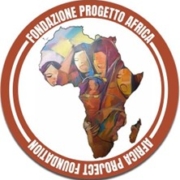Arte dell’Africa
“Arte dell’Africa” is the title of the exhibition set up on 14/15/16 May 2004 and curated by the International Institute of Communication at the Abbey of Sant’Andrea in Flumine in Ponzano Romano (RM). After almost 20 years, the president of our foundation, remembers this event as the only occasion in which objects from his private collection, collected from life in Africa, were put on display. To date, these masks, statuettes, paintings, tools, and fabrics are the heritage of the Fondazione Progetto Africa. The exhibition was not limited only to the exhibition but, the International Institute of Communication, proposed laboratory spaces dedicated to the practical realization of objects inspired by the African tradition starting from research of shapes, materials, and colors. In the brochure of presentation of the laboratory it was said “we will help ourselves with sheets, photographs, maps on which we will project, quickly imagining historical scenarios and anthropological demos. For us, painting, photographing, illuminating, and approaching is a way of understanding the distribution of the elements, taking into account the size, proportions, and role they have in the culture of a people. We do not want to faithfully reproduce the original but understand the rules by which it was built…”.

An event attended by the Catholic community and hoping that we can give new prominence to these objects of art and crafts from the African continent, we think of a first work of cataloging and the publication of photographic albums that can serve to the testimony, the dissemination of these arts and anthropological – ethnographic collaborations as loans to museums and universities. The mask as a mere object, in itself, has a double value for what it shows and what it hides, as covering a face affirms its existence. But the mask also has a precise function and not always the same, used for disguise, for protection and to strike terror by deposing its strength even if not worn. It will be because of the anthropomorphic aesthetics or the caricatural aspect of a face but it is certain that this object is among the tools capable of linking the past to the present. Every population between practical and historical needs makes use of it, it is famous the use of this object as bridge between man and divinity during the celebrations with dances and propitiatory rites or in the theater starting from the Greek one.

In the common aesthetic, what appears to us to be endowed with expression is as if it imputes a direct reaction to the acceptance of this image or to its total rejection by placing us in immediate dialogue. Finally, it is important not to forget the apotropaic and literary value present in the abstract side of the object and that is addressed to us universally in a dynamic relationship and adapted to cultures, but to tell its physical structure, are materials such as carving tools, colors and proportions defined by the sensitivity of the craftsman or artist. There are in fact criteria, defined by the merchants, that identify some restrictive parameters for an African tribal object to be art: must be made exclusively for the purposes




